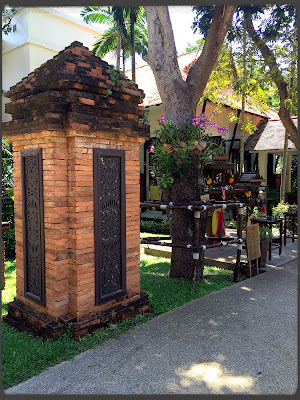The Diamond Princess navigated across the Gulf of Thailand and found anchorage off the port of Koh Samui (pronounced Ko Sam-moo-ee) in the gulf. This would be a tender port.


We were brought to Na Thon Pier, an approximately 3-5 minute walk from Na Thon Town and located on the west coast of Koh Samui island.

Thai long tail boats were docked along the pier full of colorful fishing gear and the morning catch.


Improvisation fascinates me and I saw loads of it in the Asian cultures. People displayed all types of ways to transport and tweak vehicles and engines to fit their needs and lifestyle.

This was the beginning of many, many sightings of "spirit houses" or San Phra Phum. A spirit house sat prominently outside every business establishment, outside every home and Buddhist temple. They came in all sizes and ranged from a simple Thai-style mini-home to a mini palace. The spirit house construction depends on two factors: what kind of spirit is being invited and how much the owner is willing to spend. The purpose is to provide an appealing shelter for the spirits, or celestial beings, who would otherwise reside in heaven. According to folklore, the spirits can be finicky and mischievous and to disappoint one could be disastrous. We saw all types of adornment from incense burners, statues, flowers, scarves and offerings used to keep the spirits happy.






But before we go on, some important facts about Koh Samui. For starters, the capital is Bangkok located on the mainland of Thailand. The currency is the Thai Baht, made up of 100 satang. The exchange rate at the time was 32.62 Thai Baht to $1 US dollar. The official language is Thai although Chinese, Malay and regional dialects are also spoken. We encountered very little English. The main religion throughout Thailand is Buddhism. A common Thai greeting normally said at any given time of the day is "Sawasdee" and it is very polite to put both palms together in the gesture of "wai" and place them close to your heart.
Koh Samui is Thailand's second largest island after Phuket. It is a haven of sandy beaches, coral reefs and coconut trees. Actually, some have called it the biggest coconut plantation in the world. Until as recent as 1970, life around the island revolved around the coconut and the income it generated. In 1988, Bangkok Airways opened the island's airport and up-market bungalows and resorts began to spring up all along the island's beautiful beaches. The island remains accessible by sea with a large car ferry running continuously from Don Sak (mainland Thailand) to the west coast of Kho Samui and a passenger ferry running between Surat Thani (mainland Thailand) to Na Thon.
The major resort beaches on Koh Samui are Lamai and Chaweng on the east coast of the island. So our driver took us from Na Thon Town (circled in red on the left in the map below) to the Renaissance Koh Samui Resort and Spa (circled in red on the right in the map below), one of the luxury resorts located on Lamai. We wanted to see this famed beach coast and enjoy some of its splendor.









The private lagoon wasn't crowded. The sand was hot from the blazing sun but so soft. The water was so clear and refreshing, both in the pool and in the bay. There was a Thai woman giving a foot massage to a gentlemen in a bathing suit who was laying on a lounge chair underneath a canopy of trees down by the lagoon. I quickly got the impression that this resort delivered an environment of complete relaxation.




















Be transported to our next destination (Laem Chabang, Thailand) by clicking on this link: Asia and Australia 2014

No comments:
Post a Comment